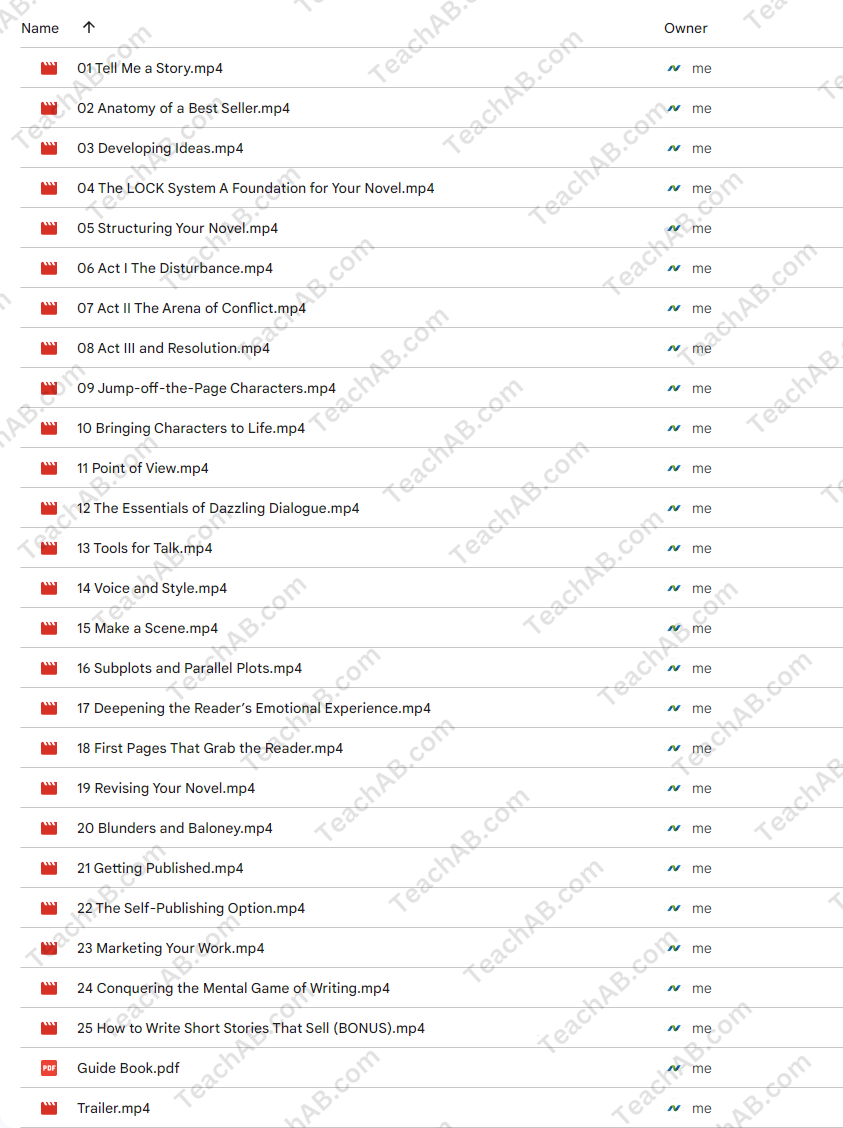How to Write Best-Selling Fiction By James Scott Bell
$239.00 $5.00
How to Write Best-Selling Fiction
Content Proof:
Creating best-selling fiction is not merely an exercise in creativity; it’s an intricate dance that involves understanding both the craft of writing and the mechanics of the publishing industry. In his enlightening course, How to Write Best-Selling Fiction, James Scott Bell embarks on a journey to demystify this complex process.
The course spans 24 lectures, offering comprehensive insights into what it takes to pen a commercially successful novel. Bell’s approach is not just about inspiring aspiring writers; it’s about equipping them with practical tools and strategies that can be applied across various genres. Through a mix of storytelling techniques, character development, and plot structuring, Bell underscores the idea that while talent plays a role, a structured writing strategy is paramount to success.
In today’s literary landscape, where thousands of books are published every month, standing out is no easy feat. Bell understands that writers are often told to rely on their muse, yet he challenges this notion by emphasizing the importance of having a well-defined writing strategy. Much like an architect drafting blueprints before constructing a building, writers should lay out a clear plan for their narratives. This structured approach not only enhances creativity but also transforms the writing process into a more enjoyable and less daunting experience.
Understanding the Core Elements of Best-Selling Fiction
Unique Ideas and Brainstorming Techniques
The journey begins with the conception of unique ideas. According to Bell, brainstorming isn’t just about generating a multitude of concepts; it’s about honing in on what makes a story resonate with readers. He prompts writers to think about their own experiences, passions, and interests, suggesting that the most authentic stories often emerge from personal narratives. Bell encourages writers to maintain a creative journal, serving as a repository for ideas that can be revisited and refined.
To generate unique ideas, Bell recommends several techniques, such as:
- Mind Mapping: Visualizing connections between ideas to inspire new narratives.
- Free Writing: Setting a timer for a designated period and writing continuously without self-editing.
- Character Prompts: Developing characters through random personality traits or occupations to spark story ideas.
Through these exercises, writers can dive beneath the surface of their imaginations and surface narratives that are both intriguing and marketable.
Crafting Compelling Characters
Once an idea has taken shape, the next step is to develop multi-dimensional characters who captivate readers. Bell asserts that characters should not merely serve the plot but should rather drive it forward. Compelling characters are often marked by their flaws, desires, and the arcs they undergo throughout the story. Drawing from the successes of renowned authors like Stephen King and Janet Evanovich, Bell illustrates how rich character development can turn ordinary plots into extraordinary tales.
Key features of compelling characters include:
- Goals and Motivations: Understanding what drives a character enables readers to connect on an emotional level.
- Conflict: Characters must navigate internal and external conflicts, presenting challenges that evoke empathy and investment from the audience.
- Growth and Change: A well-rounded character experiences growth throughout the story, reflecting the journey of the narrative as a whole.
By delving into character development, writers are encouraged to create protagonists and antagonists that feel alive, inviting readers to join them on their journeys.
Structuring Plots Effectively
The Architecture of a Story
Bell emphasizes the necessity of a solid plot structure as a means of guiding the narrative and sustaining reader interest. He likens plot structure to the skeleton of a story, providing essential support that allows characters and themes to thrive. The framework he proposes typically includes:
- Setup: Introducing the protagonist, setting, and initial conflict.
- Confrontation: Complications arise, leading to a deeper conflict.
- Resolution: The climax of the story, culminating in a resolution that brings closure.
A well-structured plot not only engages the reader but also provides a roadmap for the writer, reducing the chaos that can often accompany the writing process.
Writing Engaging Scenes and Dialogue
Equally as critical as plot structure is the ability to craft engaging scenes and dynamic dialogue. Bell teaches that scene writing should evoke sensory experience. By painting vivid imagery and appealing to the senses, writers can immerse readers in their fictional worlds. Dialogue, on the other hand, should reflect natural speech while revealing character and pushing the plot forward.
In Bell’s view, effective dialogue should:
- Advance the Plot: Dialogue should serve a purpose, whether in revealing crucial information or creating tension.
- Character Distinction: Each character should have a unique voice, defined by their background, personality, and motivations.
- Conflict and Resolution: Implementing conflict in dialogue can heighten tension and engage readers.
Both scenes and dialogue are essential in maintaining reader immersion and creating a compelling narrative flow.
Navigating the Publishing Landscape
Traditional vs. Self-Publishing
In today’s ever-evolving literary world, understanding the publishing landscape is crucial for any aspiring author. Bell provides insight into the two primary avenues: traditional publishing and self-publishing. He recognizes the merits and drawbacks of both paths while ultimately encouraging writers to choose the option that best aligns with their goals.
Traditional Publishing Pros and Cons:
| Pros | Cons |
| Access to professional editing | Lengthy submission process |
| Established distribution channels | Less creative control |
| Marketing support | Lower percentage of royalties |
Self-Publishing Pros and Cons:
| Pros | Cons |
| Full creative control | Responsibility for all marketing efforts |
| Quick publication timeline | Potentially lower visibility |
| Higher royalty percentages | Limited access to traditional distribution |
Bell’s analysis empowers writers to take informed steps forward in their publishing journey, no matter which path they choose.
Marketing Your Work
Bell also touches on marketing strategies for authors, recognizing that writing a compelling story is often just the beginning. He advocates for building an author platform, leveraging social media, and engaging with readers to cultivate a loyal audience. Marketing, in this sense, is akin to planting seeds; with time and nurturing, those seeds can blossom into a fruitful interaction with fans, increasing your visibility as a writer.
Crafting a Compelling Author Brand
An author brand transcends mere marketing; it reflects the author’s identity, values, and the unique contributions they bring to the literary world. By establishing a recognizable and authentic brand, authors can create lasting connections with readers. Bell emphasizes the importance of consistency in branding across various platforms, from social media to book covers.
To cultivate a compelling author brand, consider the following:
- Engaging Content: Share insights, behind-the-scenes glimpses, or exclusive excerpts to engage your audience.
- Visual Identity: Establish consistent visual elements, like logos and color schemes, to enhance brand recognition.
- Authentic Interaction: Connect with readers personally, responding to comments and fostering community.
By investing time in developing a robust author brand, writers can create an enduring legacy that resonates with readers long after their narratives have faded from the pages.
Conclusion
In How to Write Best-Selling Fiction, James Scott Bell provides a robust framework for aspiring authors seeking to enter the competitive world of publishing. Through a blend of imaginative brainstorming, character depth, strategic plotting, and an understanding of the publishing landscape, Bell’s course acts as both a guide and an inspiration. Whether you’re aiming for the heights of traditional publishing or the autonomy of self-publishing, the advice gleaned from Bell’s teachings is invaluable. The journey to crafting a best-selling novel may be complex, but with the right tools and strategies, success is within reach.
Frequently Asked Questions:
Business Model Innovation: We use a group buying strategy that enables participants to share costs and access popular courses at lower prices. This approach helps individuals with limited financial resources, although it may raise concerns among content creators regarding distribution methods.
Legal Considerations: Our operations navigate complex legal issues. While we do not have explicit permission from course creators to resell their content, there are no specific resale restrictions mentioned at the time of purchase. This lack of clarity allows us to offer affordable educational resources.
Quality Control: We guarantee that all course materials provided are identical to those offered directly by the creators. However, please note that we are not official providers. As a result, our services do not include:
– Live coaching calls or sessions with the course author
– Access to exclusive author-controlled groups or portals
– Membership in private forums
– Direct email support from the author or their team
Our goal is to make education more accessible by offering these courses independently, without the additional premium services available through official channels. We appreciate your understanding of our unique approach.
Be the first to review “How to Write Best-Selling Fiction By James Scott Bell” Cancel reply
You must be logged in to post a review.
Related products
Personal Development
Activate Your Money Magnetism – Become Your Richest Self in 8 Weeks – Rachael Hunt
Personal Development
Unreal Series: Multiverse Key – Talmadge Harper – Harper Healing
Personal Development
Online – Master Planning for Life USA Aug 2020 – John Demartini (Videos Only)
Personal Development
Personal Development
Magnetic Gaze Level 1: Foundations – Fabricio Astelo – Bruno Martins – Charisma School
Personal Development
The Hero Physique – Build An Aesthetic Body Naturally – Chris Archer
Personal Development
Premium Lucid Breakthrough Program – Stefan Zugor – HowToLucid
Personal Development



















Reviews
There are no reviews yet.